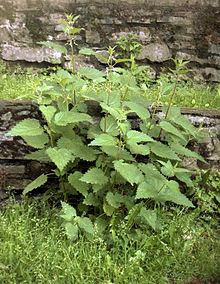
Back هستامين Arabic هیستامین AZB Гістамін Byelorussian Хистамин Bulgarian হিস্টামিন Bengali/Bangla Histamin BS Histamina Catalan ھیستامین CKB Histamin Czech Histamin Danish

Histamine is an organic nitrogenous compound involved in local immune responses. It also regulates physiological function in the gut, and acts as a neurotransmitter.[1] Histamine is involved in the inflammatory response, where tissues get red, swollen and painful.
As part of an immune response to foreign pathogens, histamine is produced by basophils and by mast cells found in nearby connective tissues. Histamine increases the permeability of the capillaries to white blood cells and some proteins. The cells get through the walls of the tiny blood vessels to get at pathogens in the infected tissues.[2]
Histamine in water exists as two tautomers in equilibrium, differing by the position of the hydrogen atom:

- ↑ Marieb E. (2001). Human anatomy & physiology. San Francisco: Benjamin Cummings. p. 414. ISBN 0-8053-4989-8.
- ↑ Di Giuseppe M.; et al. (2003). Nelson Biology 12. Toronto: Thomson Canada. p. 473. ISBN 0-17-625987-2.